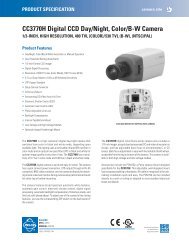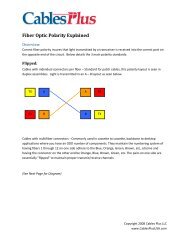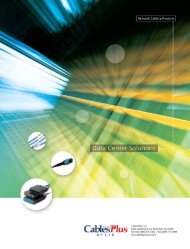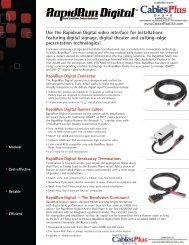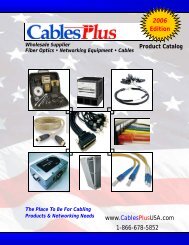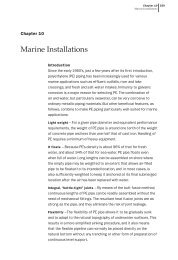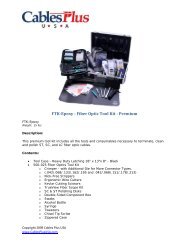Learning About Options in Fiber - Cables Plus USA
Learning About Options in Fiber - Cables Plus USA
Learning About Options in Fiber - Cables Plus USA
Create successful ePaper yourself
Turn your PDF publications into a flip-book with our unique Google optimized e-Paper software.
a trench dug <strong>in</strong> the ground and then covered.<br />
• Indirect burial, similar to direct burial, but the<br />
cable is <strong>in</strong>side a duct or conduit.<br />
• Submar<strong>in</strong>e cable is underwater, <strong>in</strong>clud<strong>in</strong>g<br />
transoceanic application.<br />
All of the forego<strong>in</strong>g cables must be rugged and<br />
durable s<strong>in</strong>ce their applications subject them to a<br />
variety of extremes. Typically, the <strong>in</strong>ternal glass<br />
fiber is the same for all types of fiber cable with<br />
some small exceptions.<br />
SECTION 2—FIBER-OPTIC BASICS<br />
smooth transition from copper to fiber is possible<br />
at a future time, basically because the hybrid<br />
cable permits the end user to be “fiber ready.”<br />
Cable designs are available with multiple elements<br />
<strong>in</strong>clud<strong>in</strong>g the specific wire or fiber types (s<strong>in</strong>gle- or<br />
multimode). <strong>Fiber</strong>s are color coded for ready identification.<br />
As with conventional cable, hybrids can<br />
be manufactured to specific requirements.<br />
Breakout Cable<br />
<strong>Cables</strong> designed for underground use may conta<strong>in</strong><br />
one or more fibers encased <strong>in</strong> metal jackets and<br />
flooded with a moisture-proof<strong>in</strong>g gel.<br />
Section 3, Table E,<br />
offers a chart of questions<br />
that should be<br />
addressed when<br />
select<strong>in</strong>g cables for<br />
various requirements.<br />
Hybrid Cable<br />
This is a unique type of<br />
cable generally available<br />
on special order<br />
only. It is designed for<br />
multipurpose applications<br />
where both optical<br />
fiber and twisted<br />
pair wires are jacketed<br />
together <strong>in</strong> those situations<br />
where both technologies<br />
are called for.<br />
This style cable is also<br />
useful when future<br />
expansion plans call<br />
for optical fiber.<br />
Figure 2-15—Hybrid Cable<br />
Hybrid cable (Figure 2-<br />
15) allows for exist<strong>in</strong>g<br />
copper networks to be<br />
upgraded to fiber<br />
without the requirement<br />
for new cable.<br />
With hybrid cable, this<br />
can be accomplished<br />
without disrupt<strong>in</strong>g the exist<strong>in</strong>g service.<br />
This cable style is also useful <strong>in</strong> applications such<br />
as local area networks (LANs) and <strong>in</strong>tegrated<br />
digital services networks (ISDNs) where easy or<br />
A breakout cable is one which offers a rugged<br />
cable design for shorter network designs. This<br />
may <strong>in</strong>clude LANs, data communications, video<br />
systems, and process control environments.<br />
A tight buffer design is<br />
used along with <strong>in</strong>dividual<br />
strength members<br />
for each fiber. This<br />
permits direct term<strong>in</strong>ation<br />
to the cable<br />
without us<strong>in</strong>g breakout<br />
kits or splice panels.<br />
Due to the <strong>in</strong>creased<br />
strength of Kevlar<br />
members, cables are<br />
usually heavier and<br />
physically larger than<br />
the telecom types with<br />
equal fiber counts.<br />
The term breakout<br />
def<strong>in</strong>es the key purpose<br />
of the cable. That<br />
is, one can “break out”<br />
several fibers at any<br />
location, rout<strong>in</strong>g other<br />
fibers elsewhere. For<br />
this reason breakout<br />
cables are, or should<br />
be, coded for ease of<br />
identification.<br />
Because this type of<br />
cable is found <strong>in</strong> many<br />
build<strong>in</strong>g environments<br />
where codes may<br />
require plenum cables, most breakout cables meet<br />
the NEC's requirements. The cable is available <strong>in</strong> a<br />
variety of designs that will accommodate the topology<br />
requirements found <strong>in</strong> rugged environments. <strong>Fiber</strong><br />
counts from simplex to 256 are available.<br />
2-11



